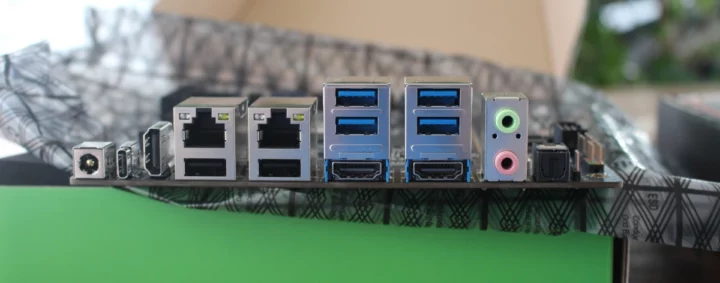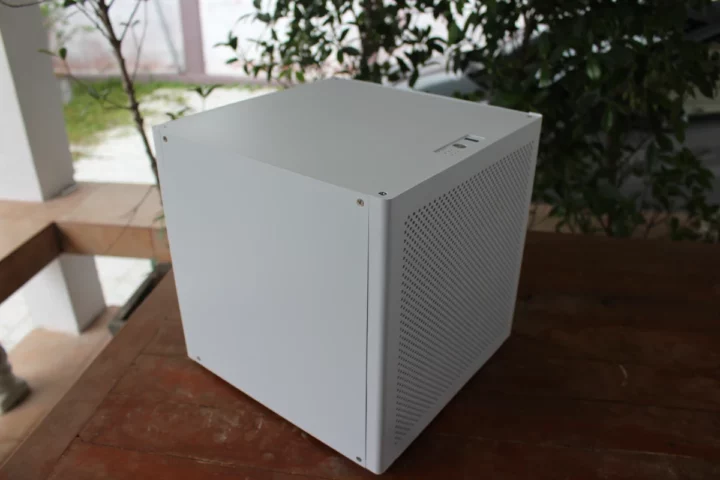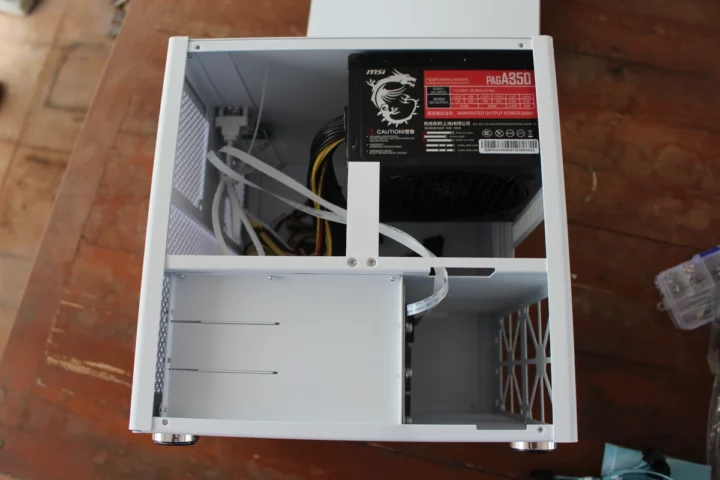Radxa ROCK 5 ITX is a mini-ITX motherboard powered by a Rockchip RK3588 octa-core Cortex-A76/A55 processor, and the Shenzhen Milk-V Jupiter is another mini-ITX motherboard, but based on SpacemIT K1 octa-core 64-bit RISC-V processor instead.
When Radxa contacted me about reviewing those, I thought it would be interesting to review a complete kit with a mini-ITX case since I had never built this type of system myself. Yesterday, I was surprised to receive two large packages and thought maybe a company sent me a 3D printer or laser engraver kit, but instead, I got one package with the two Arm and RISC-V mini-ITX motherboards and another with a mini-ITX NAS enclosure with 6x SATA bays.
Radxa ROCK 5 ITX unboxing
Let’s look at the ROCK 5 ITX motherboard and accessories first. The motherboard ships with a rear panel and two screws for the M.2 module.
The motherboard features the Rorkchip RK3588 SoC and LPDDR5 memory chips in the middle of the board, and we’ll also find four SATA ports, two M.2 sockets, headers for a PoE module, some camera and LCD connectors, and a 24-pin ATX power receptacle.
The rear panel comes with a 12V DC jack, a USB Type-C port, an HDMI input, two combo ports with 2.5GbE and USB 2.0 each, two more combo ports with two USB 3.2 and HDMI output each, two 3.5mm audio jacks, and an optional S/PDIF connector.
The bottom of the board is pretty bare except for an additional LCD connector.
My kit also includes a Radxa-branded fansink for the motherboard and a Radxa RA025 25W PoE module.
Radxa ROCK 5 ITX specifications
- SoC – Rockchip RK3588
- CPU – Octa-core processor with four Cortex-A76 cores @ 2.4 GHz, four Cortex-A55 cores @ 1.8 GHz
- GPU – Arm Mali G610MC4 GPU
- VPU
- 8Kp60 10-bit H.265 / VP9 / AVS2 decoder, 8Kp30 H.264 decoder
- 8Kp30 H.265 / H.264 encoder
- AI accelerator – 6 TOPS NPU
- System Memory – 4GB, 8GB, 16GB, or 32GB LPDDR5
- Storage
- Onboard eMMC for ROOBI OS
- M.2 2280 socket for NVMe SSD (PCIe 3.0 x2)
- 4x SATA ports with power header
- MicroSD card socket
- SPI Flash for Bootloader
- Video Output
- 2x HDMI port, one up to 8Kp60, the other up to 4Kp60
- 1x USB-C with DisplayPort Alt. mode up to 4Kp60
- 2x 4-lane MIPI DSI connectors
- 1x eDP with touch panel support
- Four independent displays supported
- Video Input
- HDMI input up to 4Kp60
- 2x 4-lane MIPI CSI connectors (also configurable as 4x 2-lane MIPI CSI)
- Audio
- 3.5mm headphone jack
- 3.5mm microphone Jack
- Front audio header
- Optical S/PDIF output
- Networking
- 2x 2.5 Gbps Ethernet RJ45 port with optional PoE support
- M.2 E-Key socket for WiFi 6 module
- USB
- 4x USB 3.0 Type-A ports
- 2x USB 2.0 Type-A ports
- 1x USB 3.0 OTG/Host Type-C port
- 2x USB 2.0 via front USB header
- Misc
- PWM fan connector
- RTC socket (CR1220 battery)
- Front Panel header for Power Button / Reset Button / Status LED
- Power Supply
- 12V DC power barrel jack (55x25mm)
- Standard 24-pin ATX power supply interface
- PoE Header (additional PoE module required)
- Dimensions – 170 x 170mm (Mini-ITX form factor)
- Temperature Range
- Recommended – 0 to 50°C
- Max – Up to 80°C
- Compliance – FCC/CE
The Rockchip RK3588 mini-iTX motherboard supports Radxa OS, Debian, or Android. The wiki will have more information about software support.
Jupiter RISC-V mini-ITX motherboard unboxing
Let’s switch to the RISC-V mini-ITX motherboard that ships with a rear panel plate and two WiFi antennas since the motherboard integrates a WiFi 6 and Bluetooth 5.2 module.
The Jupiter motherboard has fewer interfaces than the ROCK 5 ITX motherboard, but we can still find one M.2 Key-M socket for storage, a PCIe x8 slot (limited to 2-lane PCIe 2.1), and a 24-pin ATX power supply connector.
The rear panel features a 12V DC power jack, a USB-C port, an HDMI output port, two gigabit Ethernet RJ45 ports, two USB 3.0 ports, two USB 2.0 ports, and 3.5mm audio jacks for headphone and microphone. I did not get any other accessories with the motherboard. I can see two mounting holes for a heatsink or fansink, but this was not part of the package.
MILK-V Jupiter specifications
- SoC – SpacemiT K1
- CPU – 8-core X60 RISC-V (RV64GCVB) processor with RVV 1.0; compliant with RVA22
- GPU – Imagination IMG BXE-2-32 @ 819 MHz with support for OpenCL 3.0, OpenGL ES3.2, Vulkan 1.2
- VPU
- H.265, H.264, VP9, VP8, MPEG-4, MPEG-2 up to 4Kp60 decoding
- H.264, H.264, VP9, VP8 4Kp30 encoding
- NPU – 2.0 TOPS AI accelerator
- System Memory – 4GB, 8GB, or 16GB LPDDR4X
- Storage
- M.2 M Key Connector for M.2 NVMe SSD (PCIe 2.0 x2)
- MicroSD card slot
- SPI Flash for boot
- eMMC connector
- 2x 4-pin SATA power connector (I assume in case a PCIe to SATA card is used)
- Display – HDMI port up to 1920×1440 @ 60Hz
- Audio
- 3.5mm headphone jack
- 3.5mm microphone jack
- Networking
- 2x Gigabit Ethernet RJ45 ports with optional PoE support (additional PoE module required)
- Wi-Fi 6 and Bluetooth 5.2 module
- USB
- 2x USB 3.0 Type-A host ports
- 2x USB 2.0 Type-A host ports
- 1x USB 2.0 Type-C OTG port for firmware download
- 2x USB 3.0 and 2x USB 2.0 via front USB header
- Expansion – PCIe x8 slot (2-lane PCIe 2.1) with supports for graphic cards, PCIe to SATA adapters, etc…
- Debugging – 3-pin UART header
- Misc
- PWM fan connector
- RTC Socket (CR1220 battery)
- Front Panel header for Power Button / Reset Button / Status LED / Power LED
- Power Supply
- 12V DC power barrel jack (55x25mm)
- Standard 24-pin ATX power Supply interface
- Dimensions – 170 x 170mm (Mini-ITX form factor)
The board can run Fedora Remix or Canonical Ubuntu. Additional information can be found in the Wiki.
Auriga 6-Bay NAS mini-ITX chassis
I could not find the enclosure on Radxa’s website, and the company told me it’s an “Auriga” enclosure they purchased on Taobao, but I could also find it on AliExpress for $135 plus shipping.
The mini-ITX enclosure ships with four fans, a power cord, SATA cables, a screw box, a screwdriver, and other bits and pieces. I was told those are included with the case, and do not need to be purchased separately.
The rear panel comes with a power supply (not included by default), four PCIe card slots, an opening for the ports from the mini-ITX motherboard, and two mounting slots for the cooling fans.
The rest of the case is made of panels that can be easily removed to install the motherboard and other accessories. The top comes with a USB 2.0 port, a power button, and some LEDs. The front panel has plenty of holes for ventilation.
Removing one of the side panels reveals an MSI PAGA350 350W PSU sold on AliExpress for $99, but I guess it should be easy enough to source a PSU locally in most countries.
If I take the front cover out, we’ll find six SATA bays suitable for 2.5-inch or 3.5-inch SSDs or HDDs, and two more mounting slots for the remaining fans.
That will be all for today. In the second part of the review, I plan to report my experience installing the ROCK 5 ITX motherboard into the chassis and perform some basic tests since the Rockchip RK3588/RK3588S is a well-known platform that we tested with the Radxa ROCK 5B, NanoPi R6S router, Mixtile Core 3588E SoM, Khadas Edge2 Pro, and others. I’ll then switch the Arm-based ROCK 5 ITX motherboard for the RISC-V powered Jupiter mini-ITX motherboard and go through a more thorough review in the third part since it’s the first time I test a system with the SpacemIT K1 processor.
The Radxa ROCK 5 ITX motherboard can be purchased on AliExpress for $98.37 to $237.47 depending on RAM capacity, and the heatsink adds a little over $5. The Jupiter RISC-V motherboard can be found on Arace for $59.99 and up, but is currently sold out. That means reproducing the Arm setup costs around $330 to $500 before storage and other cards are taken into account, and a RISC-V NAS/workstation can be built for just under $300, again without storage.
Continue reading
- MILK-V Jupiter review – A RISC-V mini-ITX motherboard and PC tested with Ubuntu-based Bianbu OS
- Radxa ROCK 5 ITX RK3588 mini-ITX motherboard review – Building an Arm PC and NAS with Debian KDE

Jean-Luc started CNX Software in 2010 as a part-time endeavor, before quitting his job as a software engineering manager, and starting to write daily news, and reviews full time later in 2011.
Support CNX Software! Donate via cryptocurrencies, become a Patron on Patreon, or purchase goods on Amazon or Aliexpress

















